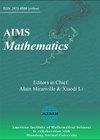具有随机波动的时变SIS流行病模型的hamilton系统的精确解和叠加规则
IF 1.8
3区 数学
Q1 MATHEMATICS
引用次数: 1
摘要
利用Lie-Hamilton系统理论,考虑了形式的广义含时Hamilton体系,该体系扩展了最近提出的具有可变感染率的SIS流行病模型。结果表明,独立于对含时系数的特殊解释,这些系统通常允许精确解,直到Lie-Hamilton系统分类中的最大扩张的情况,并为此构造了叠加规则。该方法提供了代数框架,任何保留上述性质的SIS流行病模型都要服从该代数框架。特别地,我们获得了基于书和振子代数的广义SIS哈密顿模型的精确解,用$\mathfrak表示{b}_2$和$\mathfrak{h}_4美元。最后一个推广对应于具有所谓双光子代数对称性$\mathfrak的SIS系统{h}_6$,根据嵌入链$\mathfrak{b}_2\子集\mathfrak{h}_4\子集\mathfrak{h}_6$,通常不能找到其精确解,但明确给出了非线性叠加规则。本文章由计算机程序翻译,如有差异,请以英文原文为准。
Exact solutions and superposition rules for Hamiltonian systems generalizing time-dependent SIS epidemic models with stochastic fluctuations
Using the theory of Lie-Hamilton systems, formal generalized time-dependent Hamiltonian systems that extend a recently proposed SIS epidemic model with a variable infection rate are considered. It is shown that, independently on the particular interpretation of the time-dependent coefficients, these systems generally admit an exact solution, up to the case of the maximal extension within the classification of Lie-Hamilton systems, for which a superposition rule is constructed. The method provides the algebraic frame to which any SIS epidemic model that preserves the above-mentioned properties is subjected. In particular, we obtain exact solutions for generalized SIS Hamiltonian models based on the book and oscillator algebras, denoted by $ \mathfrak{b}_2 $ and $ \mathfrak{h}_4 $, respectively. The last generalization corresponds to an SIS system possessing the so-called two-photon algebra symmetry $ \mathfrak{h}_6 $, according to the embedding chain $ \mathfrak{b}_2\subset \mathfrak{h}_4\subset \mathfrak{h}_6 $, for which an exact solution cannot generally be found but a nonlinear superposition rule is explicitly given.
求助全文
通过发布文献求助,成功后即可免费获取论文全文。
去求助
来源期刊

AIMS Mathematics
Mathematics-General Mathematics
CiteScore
3.40
自引率
13.60%
发文量
769
审稿时长
90 days
期刊介绍:
AIMS Mathematics is an international Open Access journal devoted to publishing peer-reviewed, high quality, original papers in all fields of mathematics. We publish the following article types: original research articles, reviews, editorials, letters, and conference reports.
 求助内容:
求助内容: 应助结果提醒方式:
应助结果提醒方式:


